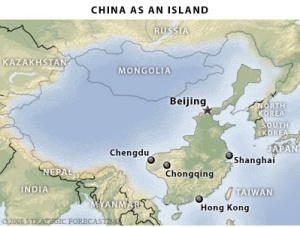You don’t think of the Han Chinese as a beleaguered island people, whose imperial diaspora takes them to distant overseas shores, but that is one lens through which to look at recent events in Urumqi.
Last year, I squirreled away a snapshot of the map below that appeared on a financial blog by John Mauldin. It shows the area of China where the bulk of Han Chinese have traditionally lived. It is an area half the size of the U.S. and today contains more than a billion people. (The population of Xinjiang, btw, is roughly the same as Madagascar’s.)
That sea of blue has always been where population pressure has pushed Han migration while at the same time being the place where, in the word’s of ancient maps, there be sea monsters. Maintaining control over the non-Han buffer zone has always been an imperative for Beijing. Yet it creates two Chinas within China: the relatively wealthy coastal areas and the often still desperately poor interior. That is a recipe for instability (especially likely, Mauldin presciently pointed out, if China’s exports fell).
There is another paradox to China’s treatment of minorities. There are some 50 within China, not just Uighurs and Tibetans. On paper, they have been granted considerable rights and privileges; semi-autonomous provinces, economic subsidies, religion guarantees, schooling in native languages, etc.; all sorts of affirmative action that go beyond anything done in the old Soviet Union or in today’s United States.
In practice, China’s minorities are being corralled into second class citizenship; there is no upward mobility for non-Mandarin educated Chinese, and a lot of the economic development in the semi-autonomous provinces, which are still party controlled, doesn’t trickle down very far. That, along with feeling economically and politically swamped by Han migration, is why Uighurs and other minorities feel oppressed, while Han Chinese don’t understand why minorities don’t feel more grateful for being made more Chinese.
One group’s assimilation is another’s repression; combine that with China’s insular geopolitics and inevitably every so often those incompatibilities will break out violently.



This Chinese tactic of overwhelming a satellite nation by immigrant population is an on Russian tactic which made little peacable Latvia 50% Russia within two generations.
It’s just force an interracial breeding programme and negate a neighbouring race, denying language, job opportunities so that eventually the memory of a country for its original countrymen is forgotten and an unknown to the offspring of Han/Chinese immigrants. It’s a disgraceful usurping of a decent people who have NO RECOURSE AND NO PATHS OF REDRESS. DEATH TO THE CHINESE. I TAKE BACK ALL I SAID ABOUT CHINA….THEY ARE NO GOOD.
Pingback: The Kazakhstan Dimension To Unrest In Urumqi « China Bystander
Pingback: Urumqi Riots Death Sentences Likely To Prompt More Protests « China Bystander
Pingback: New Reports Emerge Of Widespread Uighur 'Forced' Labour | China Bystander
Pingback: Uighurs Through The Looking Glass | China Bystander